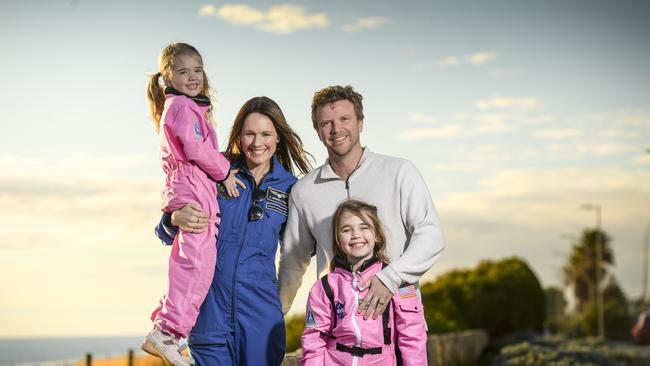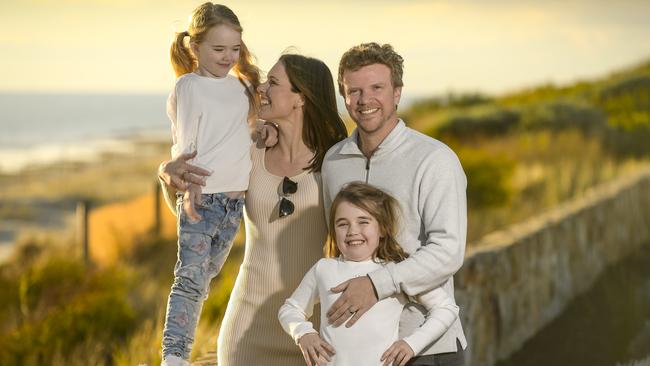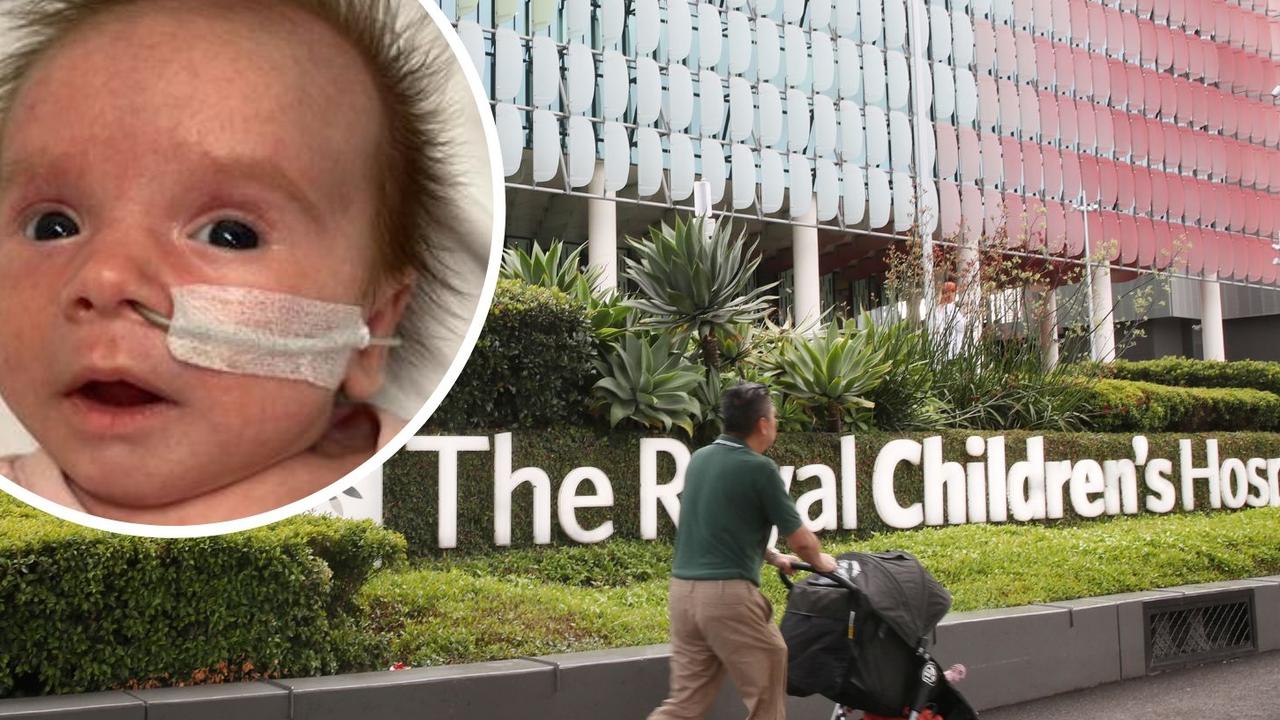Katherine Bennell-Pegg has officially qualified as Australia’s first astronaut
Katherine Bennell-Pegg is now officially qualified as an astronaut and here she shares her one pet peeve about her new-found status.

SA News
Don't miss out on the headlines from SA News. Followed categories will be added to My News.
Poking her head outside a snow cave she had just dug in the Pyrenees mountains, Katherine Bennell-Pegg is looking at the heavens.
Up there, 400km above in the night sky, the International Space Station is blipping by, completing another orbit on its endless journey around the planet.
It was, Bennell-Pegg says, “a full-circle moment” – the sight of the ISS circling the globe bringing back childhood memories and dreaming that one day she would be an astronaut and travel among the stars.
“When I was a kid I was looking up at the stars lying on the grass (in my backyard). Now I’m lying in a snow cave, looking up at the stars and seeing the space station go overhead,’’ she says.
Bennell-Pegg was in a snow cave in the Pyrenees because achieving that childhood dream is now closer than ever. She has spent the past year in Europe and the United States training to be an astronaut. It makes her the first person to be trained as an astronaut while wearing the Australian flag.
Now, after an intense 13-month training program, the 39-year-old mother of two is officially qualified as an astronaut. Her flight suit carries the silver wings of a trained astronaut. The next goal is to wear the golden wings that signify that a person has travelled into space.
Bennell-Pegg is still not certain that she will achieve the dream of space flight nurtured since she was a girl lying on the grass in the backyard of her childhood home at Curl Curl on
Sydney’s northern beaches. But she knows she is closer than ever.

Bennell-Pegg is now back in Adelaide, where she works for the Australian Space Agency, and knows nothing is guaranteed but is also grateful for the opportunity to undertake the training. After all, just reaching that stage was a remarkable achievement.
In 2021, the European Space Agency called for nominations from would-be astronauts.
It was the first time since 2009 it had gone through the process and they were inundated with more than 22,000 hopeful astronaut dreamers.
By that stage of her life Bennell-Pegg had a Bachelor of Engineering (Honours) and a Bachelor of Advanced Science (Honours) in physics. She and husband Campbell were working in Adelaide for the Australian Space Agency and the couple had two young girls, Clara and Hazel.
She applied to the ESA and after an arduous selection process, and at one point being told she was out, was finally one of seven successful candidates who would be trained as astronauts.
The reward was the training program that lasted those 13 months and included that snow cave in the Pyrenees, which was part of the winter survival training course. But there was also ocean survival, firefighting rescue, medical training, lots of engineering, zero G flights, studying space policy and space law, hours spent underwater mimicking space walks, hyperbaric chamber testing, centrifugal force machines to mimic rocket launch sensations and learning how to speak Russian.
How hard was learning Russian? “You have to construct a chess game in your head every sentence,” Bennell-Pegg says. But there is no choice. Half of the ISS is Russian-operated so you can’t pass basic astronaut training without a functional grasp of the language.
“Foreign languages are not a strength of mine and learning Russian was very challenging, but I got through it,” she says.
Talking to Bennell-Pegg at the West Beach Surf Lifesaving Club where she is a member, there is the sense that despite all the hard work, despite all the challenges, she loved the experience. She says in some ways the biggest challenges she faced were just “pacing yourself” and learning “when to stop to save your energy for the next class”.
But it’s when she talks about the training that would frighten just about anyone else that the delight kicks in. Of the fun of riding on a centrifuge that exerts pressure of 6G – even Formula One drivers only endure a maximum of about 5G.
“We got up to six Gs for quite some time, which is the typical profile (for a rocket launch) and we went through the stages, and it was dark, and you could really imagine that you’re in that rocket from a G force perspective. That was pretty great.”
Although she does concede there was at least one after-effect following release from the centrifuge.
“I was just dizzy and walked straight into a pole. So I won’t live that one down.”
Then there was the weightlessness in space training. There are two ways to do it. One is underwater. That involved diving for up to eight hours on a full-size replica of the ISS and working on it from the outside.
The other is flying on a specially modified Airbus A310 that flies a parabolic flight path that induces microgravity for 22 seconds at a time. That is, you turn weightless.

“It was really cool because you know when that plane lifts off your belly goes in your throat like you’ve jumped off a diving board, but it kind of stays there, but the smile stays there too. You just can’t stop smiling. It’s the weirdest feeling,” she says.
And it provokes a response you might not expect. “You get this instinct to swim. Maybe because Aussies are swimmers, but it’s instinctive to swim.”
But the instruction had been to avoid doing that. For one obvious reason.
“Do not kick, you’ll get someone in the nose,” was the warning.
The trick, Bennell-Pegg says, is to minimise movement. “You can move around with a push of a pinkie, so if you jump you’ll do some damage, so you learn to control movement,” she says. “If you touch something, you bounce back and you can get out of control quickly. You can spot the rookies because they’re the ones ping-ponging.”
There is also a lot to be learned in these short bursts of weightlessness. One is to learn CPR. It can’t be done the traditional way in space.
Instead, you end up doing a handstand with your hands on the patient’s chest, using your legs to push off the ceiling to create the force.
You also have to learn how to use a drill properly. If you do it incorrectly the astronaut will find themselves spinning.

There is training on how to do a space walk. Some of that is underwater. Some of that is in virtual reality. Taking a space walk one day is high on Bennell-Pegg’s wish list.
“Apparently when you open that hatch and you step out, it’s just mesmerising,” she says.
“You’re given a few minutes, actually to kind of take a breath.”
Part of that is because the sensation of looking 400km straight down at the planet below you can cause vertigo.
“You can see the northern or southern lights, you get a sunrise and a sunset 16 times a day. So you go through all that on a space walk, which might be six or eight hours. It’s like a marathon. So it’s also a physical challenge.”
For the winter survival training in the Pyrenees, the would-be astronauts, or ASCANS, (astronaut candidates) were dropped off for two days on their own. They had a shovel to dig a snow cave but could take no devices, not even an old-fashioned analogue watch or compass. There were other training days that included rescuing people from frozen lakes, then lighting fires with wet fuel to make smoke signals to call a helicopter.
The idea was “to try and push you out of your comfort zone, push you to the extreme, learn how you react, and then work on that”.
“They look for people that can make the best of any situation, whether it be good or bad,” she says.
Bennell-Pegg found that under stress she became very “fact driven”.
“I just want to know facts about everything,” she says. Which sounds admirable, but Bennell-Pegg says she has to be aware that her desire for facts left her unable to properly recognise emotions in others.
She is currently in the “pre-mission assignment” phase where the astronaut keeps working on their capabilities in the expectation that they can be allocated a flight at any time.

There were six astronauts on Bennell-Pegg’s course and some have already been selected for missions. Their advantage was that they were from nations with existing space programs.
By comparison, Australia’s space program is still in its early stages, as evidenced by Bennell-Pegg being the first Australian to train as an astronaut.
But if she does make it into space, she will aim to help Australian science. She talks enthusiastically about the potential to use space to solve Earth-bound problems such as cancer. Due to the lack of gravity, cancer cells behave differently in space. The lack of gravity causes cancer cells to age more rapidly, so scientists can watch the cancer grow much more quickly. They also see what effect cancer treatment can have much more quickly than on Earth.
“I learned so much about why space stations are so important for science on Earth,” Bennell-Pegg says. “I knew it academically, but I didn’t have the next level of deep understanding and we learned about why the unique environment of microgravity inside space stations lets you unlock science you cannot do on Earth. A lot of Australian science could be applied to that, more than we’re doing now.”
Being an ambassador for science is part of the job of an astronaut these days as well.
“The role of an astronaut has evolved over time since the eras of the ’60s and ’70s when it was more a stereotypically male alpha test pilot type. Today astronauts are scientists in the sky and scientist guinea pigs as well,” she says.
Bennell-Pegg points to the influence on children of Tim Peake, the first British astronaut who flew as part of the ESA. She says “one-in-three (UK) schools was involved in experiments on the ground tracking his experiments in space” while he was part of the ISS.
That’s the kind of impact Bennell-Pegg hopes the first Australian astronaut could have as well. She hopes to expand the horizons of what is possible for young girls.
She tells the story of a friend who had bought an astronaut suit for her four-year-old daughter. The girl didn’t want to wear it because that was “for boys”.
“Then she showed her a picture of me and the two other astronauts in my class, and she put it on, that was quite touching,” she says.
“It’s great to be able to say to little girls that they can do this, you don’t have to be a boy and just also to say to all the kids that they should be able to dream like this.”
Women are still woefully under-represented in engineering. According to Engineers Australia only 14 per cent of the engineering workforce are women and only 3.8 per cent are Australian-born women.
Bennell-Pegg remembers her early struggles in engineering. She says when applying for university, she wasn’t even sure what engineering involved and only applied because it had the word space in the title.
“At university, a lot of women, because they’re in the minority, feel like that they don’t fit the stereotype, certainly I did, and you’re often underestimated,” she says.
Bennell-Pegg says that inclination to underestimate women was even evident in some of the reporting when it was announced she had been selected for astronaut training. She says there was more focus on her gender than being the first Australian to make the grade under her own flag.
“I was quite surprised that a lot of the reporting focus was on the fact that I am the first woman to qualify as an Australian astronaut, rather than that I’m the first to officially represent Australia,” she says.
Two of the girls she wants to inspire are her own – eight-year-old Clara and six-year-old Hazel. During training, the family moved to Cologne in Germany where the training was based.


Her husband Campbell Pegg, 40, who works as a consultant in the space industry and has set up his own company Pegg High Tech, took a year off to look after their daughters while their mother was immersed in the astronaut course. Like his wife, Pegg had also grown up dreaming of travelling to space and now he says he wants his kids to one day have that option as well.
“With Katherine doing this now, there’s always a possibility they’ll do an open call one day that our kids could apply for,” he says.
“For me, it’s a very small sacrifice to allow the kids to actually have a crack at being an astronaut one day.”
Hazel has already told her mum her ambition was to be a “helicopter doctor, astronaut, mummy”.
For now, Bennell-Pegg is working at the Australian Space Agency spreading the word on the benefits of space to the economy and encouraging kids to be interested in science, while waiting for the phone call that could finally fulfil that childhood dream.
Will she make it? It’s hard to know. But either way, Bennell-Pegg is already a trailblazer and if it’s not going to be her that will be the first to wear the Australian flag in space then she has no doubt it will eventually happen.
“That’s also why this is really exciting. To have the chance to have this first door cracked open for the country, I hope to create a path for others to follow in time,” she says. “I hope to have the chance to fly but if I don’t get the chance I hope to help the next person.”
More Coverage
Originally published as Katherine Bennell-Pegg has officially qualified as Australia’s first astronaut





